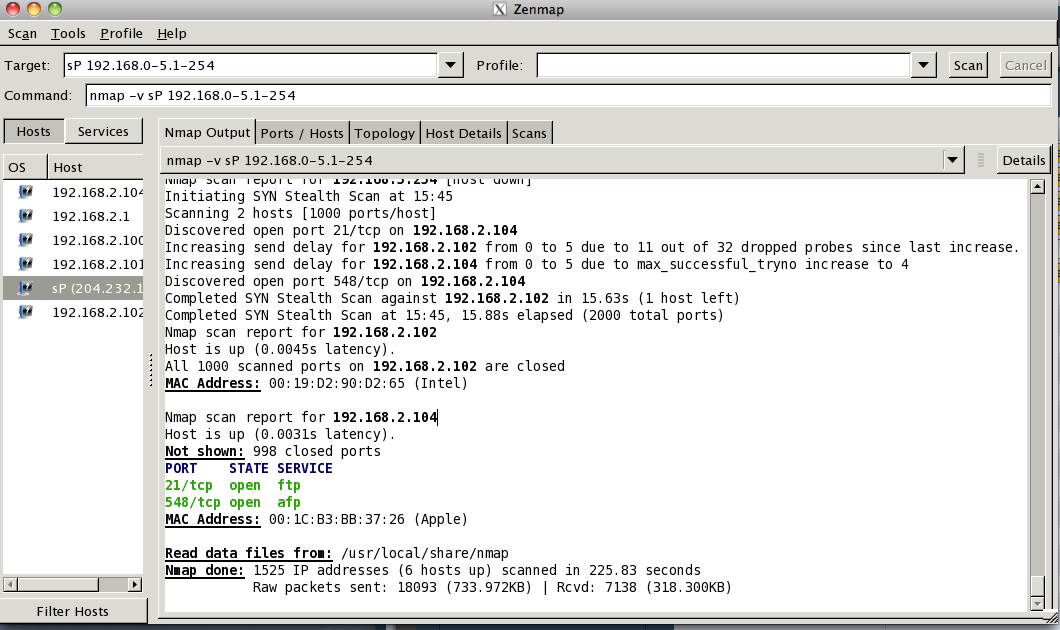

However, a stealth scan never completes the 3-way handshake, hence it's hard for the target to determine the scanning system. If SYN/ACK is received, it means the port is open, and you can open a TCP connection. Stealth scanning is performed by sending an SYN packet and analyzing the response. These ports are the ones used by popular services like SQL, SNTP, apache, etc. Scan a single host - Scans a single host for 1000 well-known ports.Ping scan - Scans the list of devices up and running on a given subnet.There are two types of scans you can use for that: Scanning the list of active devices in a network is the first step in network mapping. If you don't have Nmap installed, you can get it from here. It helps you to develop visual mappings of a network for better usability and reporting. Nmap has a graphical user interface called Zenmap.During security auditing and vulnerability scanning, you can use Nmap to attack systems using existing scripts from the Nmap Scripting Engine.It can provide detailed information like OS versions, making it easier to plan additional approaches during penetration testing. Nmap can find information about the operating system running on devices.Nmap can also detect application versions with reasonable accuracy to help detect existing vulnerabilities. Identify services running on a system including web servers, DNS servers, and other common applications.Ability to quickly recognize all the devices including servers, routers, switches, mobile devices, etc.to check if a host is up) and complex scripting through the Nmap scripting engine. Nmap helps you to quickly map out a network without sophisticated commands or configurations. There are a number of reasons why Nmap is preferred over other scanning tools.
#Zenmap scan ip range series#
Nmap is also hugely popular, being featured in movies like The Matrix and the popular series Mr. Gordon Lyon (pseudonym Fyodor) wrote Nmap as a tool to help map an entire network easily and to find its open ports and services. Nmap allows network admins to find out the devices running on their network, discover open ports and services, and detect vulnerabilities. It is an open-source Linux command-line tool that is used to scan IP addresses and ports in a network and to detect installed applications.
#Zenmap scan ip range full#
From this file we could create a full list of all IP addresses.Nmap is the short form for Network Mapper. You can use a file containing a list of IP addresses, subnets and hostnames, one per line to feed into Nmap. Select targets from a file using the -iL option. Use a dns server that is different than the default to perform reverse dns lookups -dns-server. For example you could scan a subnet and use the -exclude parameter to not scan an IP within that range. When selecting a large range of targets you may wish to specifically exclude some IP addresses. Further targeting parameters that may be of use -exclude If we however do not use the -n the command will attempt to resolve each IP address, this will take longer and will send dns queries. The commands in the above examples send no packets to the target systems, Nmap is simply listing the IP addresses in the subnet.

***** ctrl-c, listing all IP addresses will waste a lot of pixels ****** Testsystem:~$ nmap -sL -n 0.0.0.0/0 | grep 'Nmap scan report for' | cut -f 5 -d ' ' Want to list 4 billion IP addresses? Use the very same command to list all possible IPv4 addresses target 0.0.0.0/0. The target list can contain hostnames, IP addresses, subnets or a range of IPs such as 192.168.1.1-5. Additionally a second target range has been added to the target list.

In the second example the results are piped through grep and cut to extract just the IP addresses we wanted in our list. Nmap done: 4 IP addresses (0 hosts up) scanned in 0.00 seconds Below we have listed the IP addresses in the target subnet -sL with no reverse DNS lookups -n


 0 kommentar(er)
0 kommentar(er)
